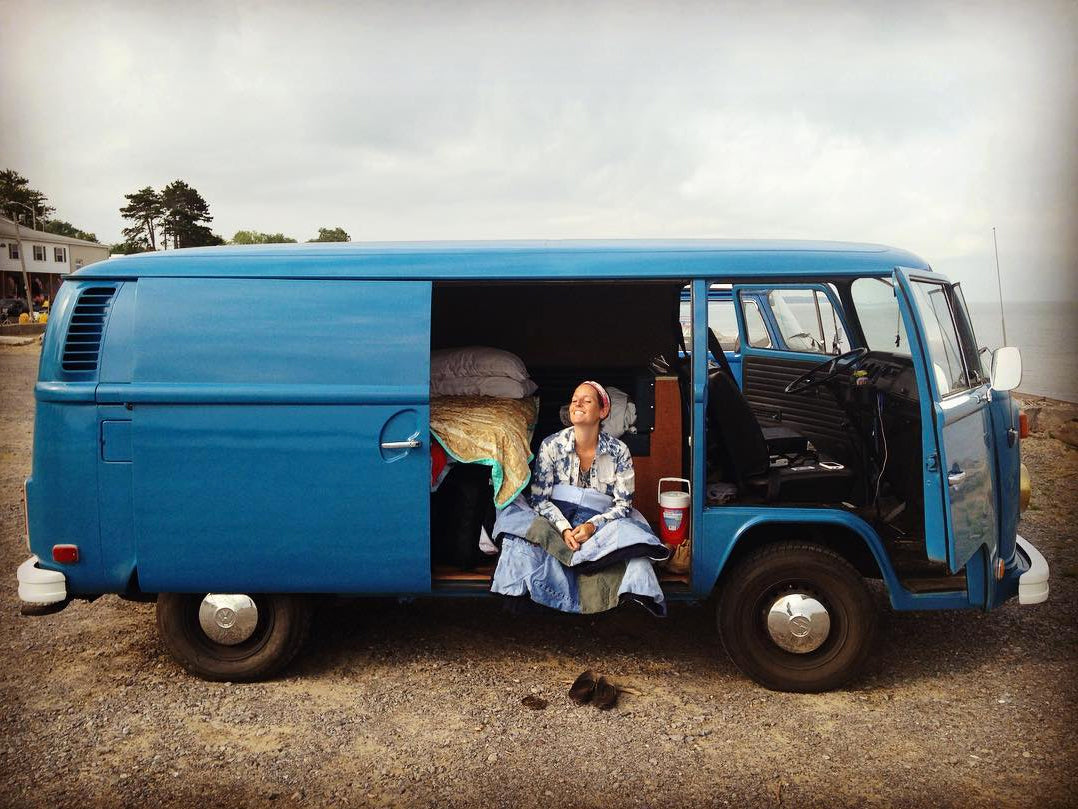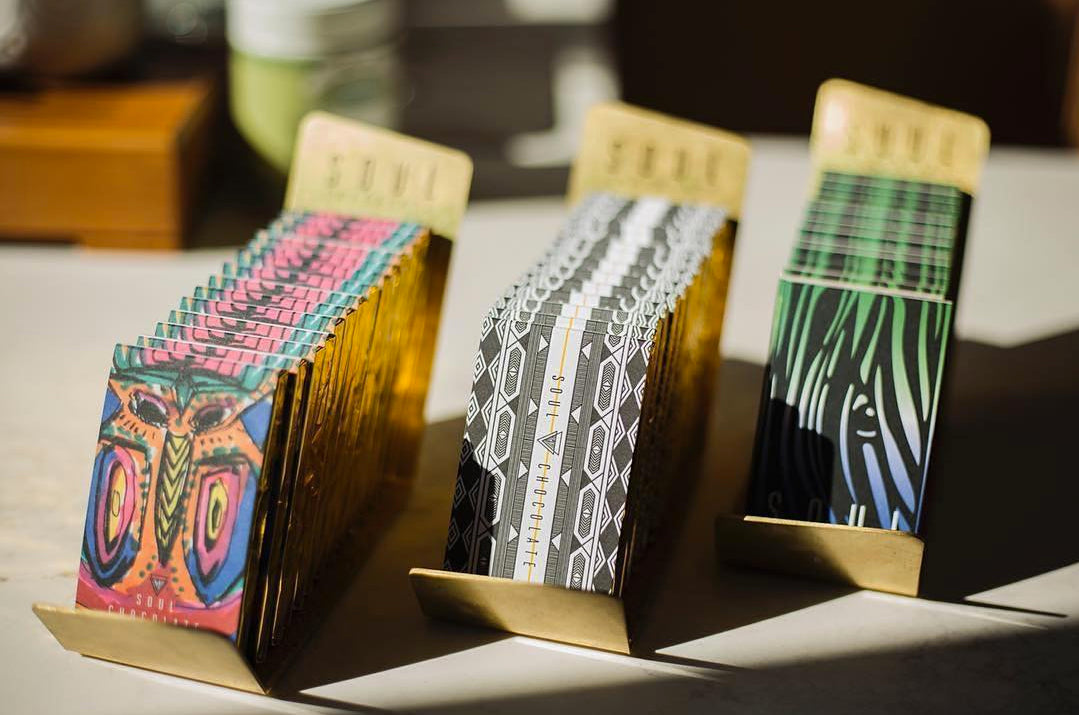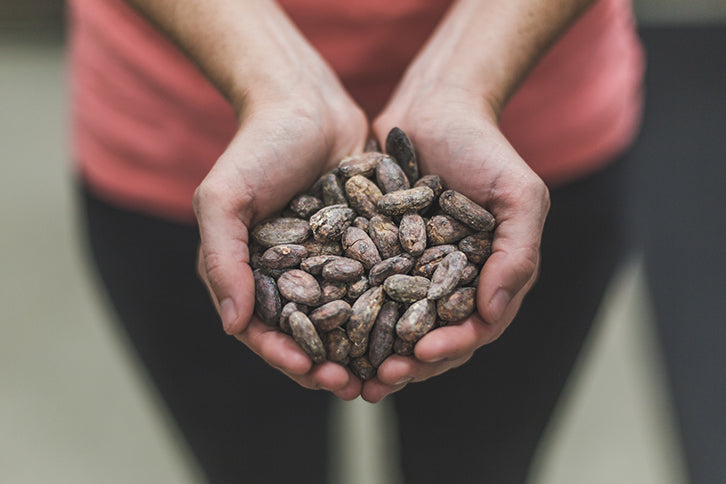Soul Chocolate's founders, Katie Bartlett and Kyle Wilsofn, met in a small community on the city fringes, finding common ground in their appetite for adventure travel.
Five years ago, drawn to bigger opportunities, they moved to Toronto where Katie worked as a baker and Kyle as a bean-slinger in the city’s burgeoning craft coffee industry. Their vacation time—every minute of it—was spent exploring remote parts of the world, immersing themselves in the rich culture of each country they visited.
While travelling in New Zealand recently, the foodies happened upon a café specializing in both coffee and chocolate. The ganache hot chocolate inspired an almost religious experience. “I couldn’t get it out of my head,” Katie tells me.
Upon returning home, she immediately enrolled in a truffle workshop at a local chocolate shop. She was hooked. Next came the professional chocolatier program, where she learned to make peppermint patties and jellies and chocolate sculptures, oh my!

photo: Matthew Wiebe
The course reaffirmed her new life path, though it didn’t cover the aspects of chocolate-making most interesting to her—the basics of bean-to-bar production were skills self-taught through trial and error, tweaking Kyle’s built-in knowledge of coffee bean roasting.
The couple’s first business—a coffee and chocolate subscription service—was their first foray into entrepreneurship. The partners in life and travel thus became partners in business. Through their freshman business, they developed their palates and their desire to own a bigger piece of the pie.
“The coffee and chocolate subscription business was a huge learning experience for us. We had the ability to taste all of the makers products around North America. Although in the end we decided to stop the service, it gave us insight into how the back end of chocolate making was done.”
The coffee and chocolate subscription business was a huge learning experience for us.
For their latest venture, bean to bar chocolate production was a no-brainer, marrying Katie’s baking and making background Kyle’s experience in roasting beans. The business also accounted for the couple’s wanderlust—sourcing beans from remote regions means that travel is just part of the job (and a tax write-off!).
The two have carved out roles in the business that play up their skills—Katie manages production, while Kyle handles more of the business aspects. "He's a great handyman, too," Katie says.

photo: Soul Chocolate/Instagram
Meet Soul Chocolate
Soul Chocolate was born out of a curiosity for the origin of things. The couple strives to discover the culinary heart of each country they visit, turning raw beans into a bar-shaped love letter to each of their favorite travel locales.
Everything, down to the package design, celebrates the origin of the beans. They hired a friend to design unique wrappers for each bar variety, inspired by the country.
“For Madagascar, the black and white, the triangle design is based on the textiles. For Venezuela, the design is a bird called a troupial—it's the national bird. The Tanzania is an abstract of the face of a zebra.”

photo: Neo Coffee Bar/Instagram
The beans are sourced directly from farmers, currently from Madagascar, Tanzania, and Papua New Guinea. Sourcing and shipping from some regions can be tricky and costly. But in the small, growing bean to bar community in Toronto, they found cooperation among competition, says Katie:
“The majority of the bean to bar makers are pretty open to where they get their cacao. With Ecuador, for example, we got in through a non profit that’s the bridge between the farmer and us. The next goal would be to get a bunch of chocolate makers together and go in on a container, because it's really expensive. Everyone's going to be getting beans from the same regions anyway. It's just a matter of putting your own touch on it in the end.”
Everyone's going to be getting beans from the same regions anyway. It's just a matter of putting your own touch on it in the end.
Katie and Kyle have discovered that each region has its own processes, with some being easier to navigate than others. Luckily, their Madagascar contact is tech-savvy and communicates by email.
“Currently Madagascar is direct trade. The farmer has storage in the states so it's really easily accessible. We kind of just wanted to see what else is out there and maybe find some smaller farmers and help them out.”
Good karma is abundant. Katie and Kyle have been fortunate to receive help from other entrepreneurs and bean to bar producers, and are happy to pay it forward.
“It's all about people and developing real relationships, not just about the dollar. People are what drive it. You never who you're going to meet, whether that person will be able to really help you in some way.”
It's all about people and developing real relationships, not just about the dollar.
About Bean to Bar
“When people think of chocolate,” Kyle says, “They think 99 cents, Hershey’s. That’s candy.” The chocolate business—real chocolate—has amassed a culture of devotees not unlike the wine industry. The discerning tastebuds of the true connoisseurs of chocolate aren’t content, merely, with “single-origin” or “80% cacao”. They're chasing the bean all the way to the bar.

photo (and header): Matthew Wiebe
"Bean to bar" refers to the process of producing chocolate end-to-end in the same facility. That facility, for Soul, is a rented kitchen space in the back of a café in Toronto’s Corktown. Within their roughly 12 by 12 foot space, they sort, roast, husk, and grind the cacao beans by hand before combining them with organic cane sugar – the only other ingredient in the bars.

photo: Matthew Wiebe
The roasting step is where brands differentiate their flavour, says Katie, “I cater to my own palate."
Because of the nature of bean to bar chocolate production, finding kitchen space—an already daunting experience—was especially challenging for Katie and Kyle. They eventually found their current space through a connection in the coffee industry, once again proving that maintaining good relationships has been essential to the business.
"Some of it was through word of mouth. We found out about a few opportunities through contacts. You could search just online, but kitchen space in Toronto is just insanely expensive. You have to pay by the hour and sometimes I think it was like $22 an hour. For us, a lot of that cooking needs to be running for three days. It just wasn't going to work.”
Palate Education
A square of Soul Chocolate’s Madagascar 70% is melting in my mouth while I type. I’m multi-tasking – writing while enjoying a self-directed tasting. The beautiful packaging lists tasting notes, thankfully. This information is helpful, as I don’t have Katie and Kyle here as guides anymore. They had advised me to start with Madagascar and move through to the richest bar, Tanzania (that being the highest in cacao content). I have a lot to learn.

photo: Matthew Wiebe
Education has become a significant part of Soul’s marketing strategy. Graduating from M&Ms to real chocolate requires a bit of context, a developing of the palate. They’re not even the same species.
Katie and Kyle have found success in partnering with wholesale clients, wineries, and restaurants to educate customers through tastings and pairing events.
We love to see how far we can push people’s idea of what chocolate should be, or should taste like.
The events have helped the couple build contacts and their brand. They’ve also gained an education in wine and pairing, inspiring ideas for new partnerships in the future.
“Our more recent tasting was with a winery called 13th Street in Niagara as part of their ‘Meet the Maker’ session. It gave us an opportunity to openly talk about chocolate, the process, our struggles, and our successes in a real, non-pitch way. It opened up discussion with people who attended and we got to pair our chocolate with some amazing wines. We learned a bit about pairing and wine so we came away with more knowledge ourselves.”

Raw cacao beans, photo: Matthew Wiebe
Wholesale & Shopify
Before Kyle and Katie opened their ecommerce store on Shopify, they initially built their business purely on wholesale orders. The couple leveraged their contacts in the industry, and many of their current clients are local Toronto coffee shops, and wineries near their home town.
They’ve synced up as well with Impact Kitchen, where they currently rent space—the cafe uses Soul Chocolate in their baked goods, and a limited edition collab bar is in the works.
When the couple decided to add an ecommerce system to their sales channels, they opened a Shopify store, and soft-launched just last October. Wholesale and ecommerce sales, in the beginning, were managed by two separate systems.
“Our biggest issue was that we were taking orders through email or text or whatever. Chasing people to pay is really difficult after a while.”
Out of the box, Shopify was meeting their needs for selling direct to consumers. But making it work for both ecommerce and wholesale required a little tweaking.
There are four ways to add wholesale pricing to an existing Shopify store:
- Discount codes: You can create custom discount codes to provide to wholesale customers. When using discount codes for wholesale, apply conditions like order value, or make the code applicable only to specific customer lists
- Apps: The Shopify App Store offers a few options for wholesale apps, starting at $19.99/month. Several have free trials.
- Open a second store: Many merchants operate two separate Shopify stores – one for ecommerce customers, one for wholesale. You can duplicate your current store to transfer content to the wholesale store.
- Customize your store: A developer can customize your Shopify theme to restrict access to wholesale pricing or collections based on customer account information.
A developer can customize your Shopify theme to restrict access to wholesale pricing.
Katie and Kyle chose the last option. The small two-person team needed to streamline wholesale and ecommerce orders, merging them into the same store to save time.
They enlisted the help of developer, Robert Bentley of Bentley HQ whom they found through Upwork, a marketplace for freelancers. (Note: many Shopify-vetted developers and designers can also be found via our Experts directory.)
Robert’s solution for Soul Chocolate was based on tagging customer accounts. The wholesale menu item brings new customers to a wholesale application. Completing the form generates a customer account, tagged as a “pending wholesaler”. Robert used Zapier to have the action generate an email notification. The shop owners, prompted by the email, can then review the application and, if approved, re-tag the customer account as “wholesale”.
Logged-in wholesale customers now experience the same storefront with additional options, explains Robert:
“It's actually working really well. I'm really proud of what we did there. There are some areas of the site that now behave differently if you're tagged as a wholesale customer. We added a wholesale menu item to the navigation and that behaves a little differently. If they're not a wholesaler, they’ll get an application form. If they are a wholesaler, it'll give them a collection or a list of products that are designated as wholesale. That's done differently for different clients. Some of them they just have a collection for wholesale products that they throw the products into. Some of them tag any products with 'wholesale' and they show up in that list.”
With the wholesale element of the site now operational, Katie and Kyle are slowly moving away from their manual process, and migrating current wholesale customers to the new system. They’ve recently upgraded their Shopify subscription to get access to real time carrier-calculated shipping, to simplify wholesale order processing.
To other shop owners considering adding wholesale to the mix, the couple offers some advice:
“When seeking wholesale customers I find it helpful to put myself in their position. What are they looking for? What information do they need? When I have a clear picture of them and their business, I know how to answer their questions and make them feel confident in myself and my products. And you just have to keep going. Take rejection as a necessary step, be okay with it, and try again. I find that's the hardest part but essential to growth and success.”
Take rejection as a necessary step, be okay with it, and try again.

photo: Matthew Wiebe
Working with an Expert
While customizing Shopify stores is his livelihood, Robert doesn’t think that everyone necessarily needs his help. When considering hiring a developer, he suggests, ask yourself if you really need customization outside of the theme’s settings:
"Shopify does a very good job of letting people basically get products out there. I don't think you always need a developer. Some people want to customize things just for the sake of it, but a lot of cases I think that's overkill. What I've noticed more and more as I've been doing this, is that a lot of people like Soul are coming up with a lot of really creative ecommerce businesses—custom boxes, customizable monthly subscriptions. When the functionality of your site is unique to your business, then you essentially have to consider a developer to help you tailor a solution."
Some people want to customize things just for the sake of it, but a lot of cases I think that's overkill.
When considering hiring a developer, remember that “too good to be true” is likely just that. Spending a little extra up front to hire a reputable developer or designer will save you headaches in the long run.
“Many people on Upwork are super cheap,” says Kyle, “It's really tempting when you see that someone can do it for $15 an hour. Then you realize this person doesn't know what they're doing.”
The Future of Soul
With the site almost done, Katie and Kyle are back in the kitchen whipping up new ideas. They’ve recently launched new product using the cacao husks (the outer shell of the beans). The husks are roasted with coconut flakes and maple syrup to create an aromatic tea.
The tea, along with a holiday advent calendar that’s currently in the works, are seasonal additions that they hope to sell in person at pop-up markets this fall. Dabbling in retail is not only a chance to meet and educate customers face to face—it’s also a long term goal.
“Eventually we do want to move back to Niagara—we're actually both from near that area—and we'd like to have a place along the wine route with a barn where we'd roast out. Then maybe we'd have a little bit of retail there for tours and tastings.”

Kyle and Katie, photo: Matthew Wiebe
The business is also helping the couple build a life centred around their love of travel. In its infancy, however, they’re a team of two running every aspect of the business from production to shipping to customer service. Travel at the moment is strictly business.
“We went to Africa and down to Tanzania and saw the cocoa and coffee plantations which was really cool. I think for the time-being we'll have to plan travel around the business. If we’re going to go travelling to the origin, it's going to be for a specific purpose and we're going to bring back some cacao. But ideally when we do have employees and we've grown enough, we'll do a lot more travelling.”
At this growth rate, they'll be hiring within the year, getting them one step closer to their goal. The key to their success so far, they say, has been their dedication to people—customers, wholesale clients, partners, farmers—and relying on a close community of entrepreneurs.
“The best resource for us has been meeting other individuals trying to make their own business ideas a reality, learning from their mistakes and sharing some of our own successes and failures so they can either skip them or try them for themselves! Meeting up in person, connecting with others—it's something I find we don't get enough of, and it's worth it.”
Read more
- How Cursor & Thread Monetizes Their Passion With Shopify
- Planting Change- How This CBD Beauty Brand Hopes to Lift Rural America
- How Slyde Handboards Landed Shark Tank Investments from Mark Cuban and Ashton Kutcher
- The Story of Ugmonk- From Side Project to Lifestyle Product Empire
- Gotamago's Story- Building a Life and a Business Under One Roof
- Why Working From the Road Is Good for Business (and How to Do It)
- How New Ecommerce Shoe Company Greats Brand is Aiming to Become the Warby Parker of Footwear
- A Day in the Life of Sophia Pierro, Entrepreneur
- The Art of Streetwear- How the Legends League Turned a Creative Outlet into a Brand





